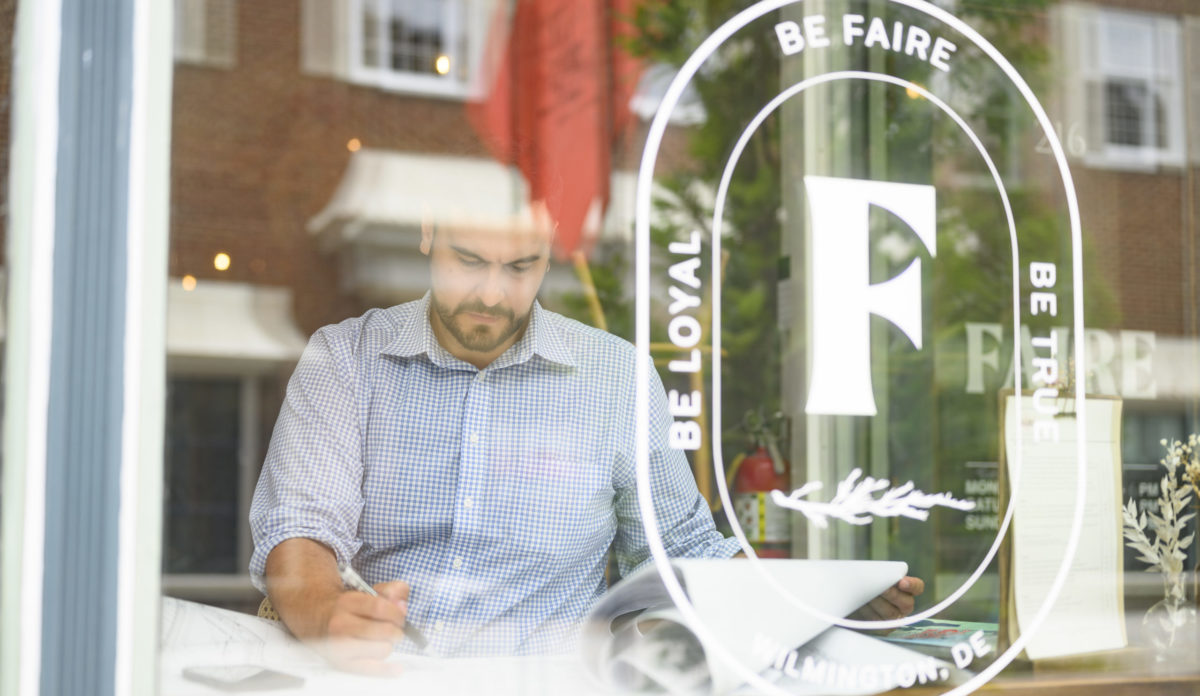Robert Herrera and partners are reimaging a vital block of Downtown Wilmington
By Ken Mammarella
Robert Herrera “romanticizes what America’s downtowns can become.” And in Wilmington, he turns that romance into reality.
His latest venture is downtown’s Faire Café, a community-nurturing space in the first building he bought. He and his partners are also adding apartments nearby, expanding The Mill (more space for co-working downtown and establishing a space in Pittsburgh) and thinking a lot about experiences.
“The more we are in a digital world, the more we will crave experiences,” he said. “Too many developers are building vertical suburbias. We’re not. We’re building a walkable community.”
He knows that downtown Wilmington is walkable – he walks to work from Happy Valley – and the cafe’s address (219 W. Ninth St.) generates a Walk Score of 89 out of 100. That’s the good.
The bad is how the area suffered in 2020 after the death of George Floyd, when social unrest degenerated into ransacking and decimation.
Herrera hopes he’s building a community at the café, as “a brand that makes you belong,” he said. “Faire is a lifestyle,” the opening announcement proclaimed.
The lifestyle starts with interior design by Dallas Shaw, heavy on a rattan and dried florals, accented with textured walls and dishes that look artisanal but are actually unbreakable. A life-size wicker motorcycle is striking, and a half-dozen swings “give it to the ’Gram,” Herrera said.
The lifestyle continues with an eclectic menu of sandwiches, toasts, bagels, salads and snacks, plus coffees and cocktails, perhaps enhanced with syrups and bitters. Some menu items honor local places, and some honor local people, such as the Weathers (spinach salad, named for partner Steve Weathers) the Snowberger (kale salad, named for partner Rob Snowberger) and the Herrera (prosciutto sandwich, named for you know). Ironically, Herrera prefers the Silverfox (chicken sandwich) but at 36, he is too young to be a silver fox.
Expect the menu to change. “I like to empower my staff to be creative,” he said, and he also wants them to offer samples to customers and encourage conversations about the food (and everything else).
The lifestyle also includes the music: Spotify’s Sunny Morning during this interview. Staffers have also made playlists, including a folky-rock Coffeehouse Creative from bar manager John Sheetz.
Herrera, Weathers and Snowberger bought the long-vacant building in 2016 from the federal government. They then bought six more buildings, giving them almost-complete ownership of the block bounded by Ninth, Orange, Girard and Tatnall streets. Buccini/Pollin Group owns the last one.
Herrera and his partners’ buildings now include 24 apartments (there’ll be 44 by year-end) and seven commercial tenants. They own three (the café; Girard Craft and Cork, an upscale package store; and Blitzen, a seasonal bar). Their tenants include the DeCoursey Beauty Lounge, a salon; Red Brick Partners, a marketing firm; WhyFly, an internet service provider; and the NERDiT Now Foundation, which refurbishes old computers and donates them to the poor to help bridge the digital divide.
When Blitzen opens in November, it will stay open year-round, Herrera said. And to complement the bar, the café will add later hours. It now closes at 6 p.m. Tuesdays-Fridays and 3 p.m. Saturdays.
Herrera grew up in Dover and earned a bachelor’s degree in architecture and a master’s degree in infrastructure planning from the New Jersey Institute of Technology. He then worked as an architect for six years in New York, including a long stint commuting from Wilmington.
“Jurgita is the source of all my inspiration,” Herrera said of his wife, who wanted to stay in Wilmington to be near familly. “You can do so many things when you have a partner in life.”
Projects for WeWork and other assignments around the nation and world taught him a lot that he would use in both The Mill and in the block with Faire.
He created The Mill with Chris Buccini and Dave Pollin. The co-working space opened in 2016 with 12,500 square feet in the Nemours Building. It has since expanded to 98,000 (in the Nemours Building and The Mill Concord in North Wilmington).
They’re adding another 33,000 square feet downtown that will include podcasting suites and a rooftop terrace. And they’re committed to creating another Mill in Pittsburgh’s Lower Hill district.
Herrera’s client WeWork is probably the most famous co-working company, but he said the concept easily goes back to the 1989 founding of Regus, and it has evolved all along. Co-working is increasingly popular because such spaces can more easily adapt when outside forces disrupt businesses.
“If DuPont doesn’t know what the world will be like in 10 years, how could a startup?” he said. That’s why Mill leases are as short as a month, with spaces and configurations adjustable.
Happy hours, formal events, ping-pong games (conference rooms are sized for the tables, too) and chance hallway encounters add value. “In co-working, you build a community,” he said.
And sometimes that community moves with you. WhyFly, for instance, started in The Mill. And When NERDiT settles in, it will mark the first time in more than 20 years that this block is filled. And that’s the way to build a community.





